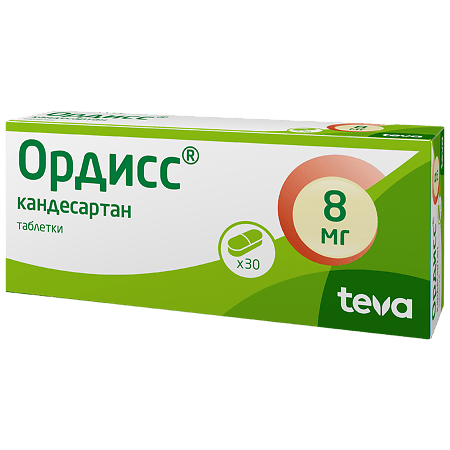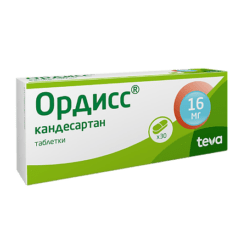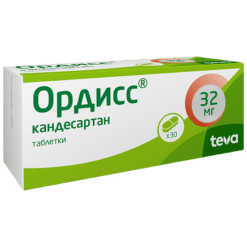No products in the cart.
Ordiss, tablets 8 mg 30 pcs
€17.39 €14.49
Description
Hypertension (high blood pressure), Heart failure
Arterial hypertension.
Chronic heart failure and impaired left ventricular systolic function (left ventricular ejection fraction (LVEF) of 40% or less) as adjunctive therapy with ACE inhibitors or when ACE inhibitors are intolerant.
Indications
Indications
Arterial hypertension.
Chronic heart failure and impaired left ventricular systolic function (left ventricular ejection fraction (LVEF) not more than 40%) as additional therapy with ACE inhibitors or in case of intolerance to ACE inhibitors.
Special instructions
Special instructions
Renal dysfunction. During the use of the drug Ordiss®, as with the use of other drugs that inhibit the RAAS, in some cases, renal dysfunction may develop.
When using the drug Ordiss® in patients with arterial hypertension and severe renal failure (creatinine clearance less than 30 ml/min), it is recommended to regularly monitor the potassium content and creatinine concentration in the blood serum. Clinical experience with the drug in patients with end-stage renal failure (creatinine clearance less than 15 ml/min) is limited. When using the drug Ordiss® in such patients, it is necessary to select the dose of the drug Ordiss® under blood pressure control.
In patients with chronic kidney disease, renal function should be periodically monitored, especially in patients over 75 years of age and in patients with impaired renal function. When increasing the dose, it is also recommended to monitor the potassium content and creatinine concentration in the blood serum.
There is no data on the use of the drug Ordiss® for CHF with a creatinine concentration of more than 265 µmol/l (more than 3 mg/ml).
Hemodialysis. During hemodialysis, blood pressure may be especially sensitive to AT1 receptor blockade as a result of a decrease in blood volume and activation of the RAAS. Therefore, patients on hemodialysis need to monitor blood pressure and individually select the dose of Ordiss® in accordance with blood pressure levels.
Simultaneous use with ACE inhibitors for CHF. When used simultaneously with ACE inhibitors, the risk of side effects increases, especially renal dysfunction and hyperkalemia. The clinical condition of patients and relevant laboratory parameters should be monitored.
Renal artery stenosis. Drugs that affect the RAAS (eg, ACE inhibitors) may lead to increased serum urea and creatinine concentrations in patients with bilateral renal artery stenosis or solitary renal artery stenosis. A similar effect can be expected with the use of angiotensin II receptor antagonists.
Kidney transplantation. There is no experience with the use of Ordiss® in patients who have recently undergone kidney transplantation.
Arterial hypotension. In patients with CHF, arterial hypotension may develop when using the drug Ordiss®. It is also possible to develop arterial hypotension in patients with BCC deficiency, for example, when using large doses of diuretics. In this case, before using the drug Ordiss®, it is necessary to correct the blood volume.
General anesthesia and/or surgical interventions. In patients receiving angiotensin II antagonists, hypotension may develop during general anesthesia and during surgery as a result of blockade of the RAAS. In rare cases, hypotension may be severe, requiring intravenous fluids and/or vasopressors.
Stenosis of the aortic and/or mitral valves, HOCM. When using the drug Ordiss® in patients with HOCM or hemodynamically significant stenosis of the aortic or mitral valves, caution should be exercised.
Primary hyperaldosteronism. Patients with primary hyperaldosteronism are usually resistant to therapy with antihypertensive drugs that affect the RAAS, so the use of Ordiss® in this group of patients is not recommended. Hyperkalemia. Concomitant use of Ordiss® with potassium-sparing diuretics, potassium preparations or salt substitutes containing potassium, or other drugs that can increase serum potassium levels (for example, heparin) may lead to the development of hyperkalemia in patients with arterial hypertension.
Hyperkalemia can also develop in patients with CHF taking the drug Ordiss®. During therapy with Ordiss® in patients with CHF, it is recommended to periodically monitor the potassium content in the blood serum, especially with the simultaneous use of ACE inhibitors and potassium-sparing diuretics (spironolactone, triamterene, amiloride).
General. Patients whose vascular tone and renal function are predominantly dependent on the activity of the RAAS (for example, patients with severe chronic heart failure, kidney disease, including renal artery stenosis) are especially sensitive to drugs acting on the RAAS. The use of such drugs is accompanied in these patients by severe arterial hypotension, azotemia, oliguria and, less commonly, acute renal failure. The possibility of developing the listed effects cannot be excluded when using angiotensin II receptor antagonists. A sharp decrease in blood pressure in patients with ischemic cardiopathy, cerebrovascular diseases of ischemic origin when using any antihypertensive drugs can lead to the development of myocardial infarction or stroke.
Use in pediatrics. The safety and effectiveness of using Ordiss® in people under 18 years of age have not been established.
Active ingredient
Active ingredient
Candesartan
Composition
Composition
Tablets weighing 8 mg
1 tablet contains:
active substance:
candesartan cilexetil 8.0 mg/16.0 mg/32.0 mg;
excipients:
pregelatinized starch 3.75 mg/7.5 mg/15.0 mg;
poloxamer 188 0.5 mg/1.0 mg/2.0 mg;
povidone-KZO 4.0 mg/8.0 mg/16.0 mg;
red iron oxide dye (E172) 0.075 mg/0.15 mg/0.3 mg;
carmellose calcium 1.65 mg/3.3 mg/6.6 mg;
microcrystalline cellulose 17.5 mg/35.0 mg/70.0 mg;
lactose monohydrate 43.725 mg/87.45 mg/174.9 mg;
magnesium stearate 0.8 mg/1.6 mg/3.2 mg.
Contraindications
Contraindications
Hypersensitivity to candesartan and other components of the drug; lactose intolerance; lactase deficiency; glucose-galactose malabsorption syndrome; severe liver dysfunction and/or cholestasis; pregnancy; breastfeeding period; children under 18 years of age; simultaneous use with aliskiren in patients with diabetes mellitus and impaired renal function (creatinine clearance less than 60 ml/min).
Side Effects
Side Effects
The incidence of side effects is classified according to the recommendations of the World Health Organization: very often – at least 10%; often – at least 1%, but less than 10%; infrequently – not less than 0.1%, but less than 1%; rarely – not less than 0.01%, but less than 0.1%; very rarely – less than 0.01%, including isolated messages.
From the blood and lymphatic system: very rarely – leukopenia, neutropenia, thrombocytopenia, agranulocytosis.
From the immune system: very rarely – skin rash, itching, urticaria, angioedema.
From the nervous system: often – dizziness, headache, weakness.
From the respiratory system: often – respiratory infections, pharyngitis, rhinitis.
From the gastrointestinal tract: very rarely – nausea.
From the cardiovascular system: often – a pronounced decrease in blood pressure.
From the liver and biliary tract: very rarely – increased activity of liver transaminases, impaired liver function, hepatitis.
From the musculoskeletal system and connective tissue: very rarely – back pain, arthralgia, myalgia.
From the kidneys and urinary tract: often – impaired renal function (see section “Special instructions”).
Laboratory indicators: very rarely – hyperkalemia, hyponatremia, increased creatinine concentration, hyperuricemia, decreased hemoglobin.
Other: very rarely – exacerbation of gout, “flushes” of blood to the face.
Interaction
Interaction
With simultaneous use of candesartan with hydrochlorothiazide, warfarin, digoxin, oral contraceptives (ethinyl estradiol/levonorgesrel), glibenclamide, nifedipine and enalapril, no clinically significant drug interactions were identified.
With simultaneous use of candesartan with ACE inhibitors, other angiotensin II receptor antagonists, aliskiren, the risk of developing hyperkalemia, a sharp decrease in blood pressure, and renal dysfunction, including acute renal failure, increases, which requires careful monitoring of blood pressure, as well as indicators of renal function and water-electrolyte balance.
The simultaneous use of candesartan with aliskiren in patients with diabetes mellitus and impaired renal function (US less than 60 ml/min) is not recommended. Candesartan is metabolized in the liver to a small extent with the participation of the CYP2C9 isoenzyme. Interaction studies have not revealed the effect of candesartan on the CYP2C9 and CYP3A4 isoenzymes; the effect on other isoenzymes of the cytochrome P450 system has not been studied.
The simultaneous use of candesartan with other antihypertensive drugs enhances the antihypertensive effect.
Experience with the use of other drugs acting on the RAAS shows that concomitant therapy with potassium-sparing diuretics, potassium preparations, salt substitutes containing potassium, and other drugs that increase serum potassium (for example, heparin) can lead to the development of hyperkalemia.
With the simultaneous use of lithium preparations and ACE inhibitors, a reversible increase in the concentration of lithium in the blood serum and the development of toxic reactions occur. Similar reactions can also occur when using angiotensin II receptor antagonists, and therefore it is recommended to monitor the lithium content in the blood serum.
Concomitant use with non-steroidal anti-inflammatory drugs (NSAIDs), including selective cyclooxygenase-2 (COX-2) inhibitors, acetylsalicylic acid (more than 3 g/day) and non-selective NSAIDs, may reduce the antihypertensive effect of candesartan and may also lead to an increased risk of renal dysfunction, including the development of acute renal failure and an increase in serum potassium. The combination of these drugs should be used with caution, especially in elderly patients.
Overdose
Overdose
Symptoms: analysis of the pharmacological properties of the drug suggests that the main manifestation of an overdose may be a clinically pronounced decrease in blood pressure and dizziness. Isolated cases of drug overdose (up to 672 mg of candesartan) have been described, resulting in the recovery of patients without serious consequences.
Treatment: with the development of a clinically significant decrease in blood pressure, it is necessary to carry out symptomatic treatment and monitor the patient’s condition. Place the patient on his back and elevate his legs. If necessary, the volume of blood volume should be increased, for example, by intravenous administration of 0.9% sodium chloride solution. If necessary, sympathomimetic agents can be used. Removal of candesartan by hemodialysis is ineffective.
Manufacturer
Manufacturer
Pliva Hrvatska d.o.o., Croatia
Additional information
| Manufacturer | Pliva Hrvatska d.o.o., Croatia |
|---|---|
| Medication form | pills |
| Brand | Pliva Hrvatska d.o.o. |
Other forms…
Related products
Buy Ordiss, tablets 8 mg 30 pcs with delivery to USA, UK, Europe and over 120 other countries.

















